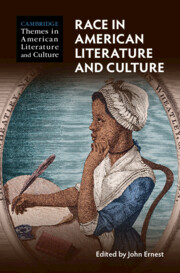Book contents
- Race in American Literature and Culture
- Cambridge Themes in American Literature and Culture
- Race in American Literature and Culture
- Copyright page
- Contents
- Contributors
- Acknowledgments
- Introduction
- Part I Fractured Foundations
- Part II Racial Citizenship
- Part III Contending Forces
- Part IV Reconfigurations
- Chapter 10 Passing
- Chapter 11 Beyond Assimilation
- Chapter 12 Native Reconfigurations
- Chapter 13 Dispossessions and Repositionings
- Chapter 14 “White by Law,” White by Literature
- Part V Envisioning Race
- Part VI Case Studies
- Part VII Reflections and Prospects
- Index
Chapter 12 - Native Reconfigurations
from Part IV - Reconfigurations
Published online by Cambridge University Press: 26 May 2022
- Race in American Literature and Culture
- Cambridge Themes in American Literature and Culture
- Race in American Literature and Culture
- Copyright page
- Contents
- Contributors
- Acknowledgments
- Introduction
- Part I Fractured Foundations
- Part II Racial Citizenship
- Part III Contending Forces
- Part IV Reconfigurations
- Chapter 10 Passing
- Chapter 11 Beyond Assimilation
- Chapter 12 Native Reconfigurations
- Chapter 13 Dispossessions and Repositionings
- Chapter 14 “White by Law,” White by Literature
- Part V Envisioning Race
- Part VI Case Studies
- Part VII Reflections and Prospects
- Index
Summary
In the United States, ways of thinking about race have their roots in both the institution of slavery and settler-colonial policies. For Native and Black peoples, the logic of blood quantum and the “one-drop” rule have worked in tandem as foundations for maintaining white supremacy and a settler logic to eliminate the Native and undermine Black participation in the nation. Many Native intellectuals, from the turn of the twentieth century, created personal narratives to position themselves as speakers on behalf of a wider Native public, to represent Indian Country almost as a distinct nationality, in the hopes of unsettling dominant discourses concerning fitness for citizenship within the United States that were intimately tied to these notions of race. They eagerly participated in American culture to reshape national narratives that had disavowed the roles Native people ought to play within the United States. This chapter highlights how Native-authored texts responded to assimilation projects developed out of boarding schools, allotment, and the promise of American citizenship, and which furthered the logic of elimination. Including this Indian-based dialogue as a core facet of American literary history pushes at the boundaries of the field and its underlying assumptions concerning race, literature, and America.
- Type
- Chapter
- Information
- Race in American Literature and Culture , pp. 195 - 209Publisher: Cambridge University PressPrint publication year: 2022
- 1
- Cited by

